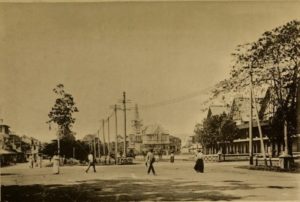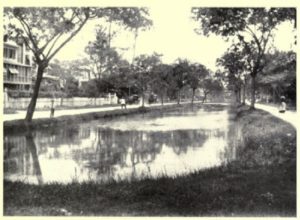By Luke M. Hill, M. Inst. C.E.

Georgetown, the capital of British Guiana, was first established by the Dutch on the Second Island, some miles up the Demerara River, whence it was transferred to Stabroek in 1782.
Stabroek was a government reservation lying between Plantations Vlissengen and Werk-en-Rust, allotted for government offices and residences for the chief officials and leading colonists; and now forms a central ward of the City of Georgetown, which gradually spread itself right and left along the river facades of the adjoining plantations of Vlissengen, La Bourgade and Eve Leary to the north, and Werk-en-Rust and Le Repentir to the south, extending nearly two miles along the river front by a depth of about one mile, the town being symmetrically laid out in wide streets forming rectangular blocks of building lots.
Georgetown was so named in the year 1812, under the Regency; and some 25 years later, with the creation of a Bishopric of Guiana and of the Cathedral of St. George’s, it was constituted a city; the city corporation of Mayor and Town Council being established by Ordinance in 1837 under the Governorship of His Excellency Sir James Carmichael Smyth.

No census has been taken since 1891 when the population was returned at 53,176; but the present population of the city and environs is estimated to be over 60,000.
The entrance to the Port of Georgetown is commanded by the guns of Fort William Frederick. This Fort mounts 21 muzzle loaders, now used for saluting purposes but also has a few modern quick-firing guns, capable of more effective work.
The Demerara Lightship (which also forms a pilot station) is anchored some ten miles beyond the Fort in five fathoms of water, from which the fairway shallows to 19 feet on the bar at high water of spring tides, the only available channel for large vessels being marked by buoys.
A short distance inside the Fort is the Lighthouse, a brick building painted red and white in vertical stripes, 103 feet high, exhibiting a strong revolving white light, flashing once every minute, and said to be visible on a clear night for a distance of over 20 miles.
A stranger’s first impression of Georgetown as he enters the Port with its fast-running mud-laden current, is not a favourable one; all he sees is an unattractive row of galvanized iron roofs, covering store-buildings projecting out over the mud-flat forming the river foreshore, with wharves or wooden stellings, alongside of which steamers, ships and lighters discharge their cargoes; and it is not until he lands in Water street, the leading business thoroughfare, that he realizes that he is in a real live city, provided with all modern conveniences, attractive shops and business places.
The tropical beauty of Georgetown is revealed as he crosses east into High, Main and other streets of private residences with their glowing wealth of colour and luxuriant growth of vegetation in the surrounding gardens of the detached residences: many of the principal streets have large canals or water reservoirs running down the centre, covered with luxuriant Victoria Regia and Lotus lilies, and flowering trees of several varieties line the sides of the roadways.
The site of the city of Georgetown, in common with all the coast-lands of the colony, is an alluvial flat, the mean level of the surface being four feet under the high water of spring tides, the sea being kept out by a massive sea-wall, forming a breezy esplanade on the sea front, and by river and wharf walls along the river bank.
The buildings of Georgetown with but few exceptions are substantially framed in the celebrated hardwoods of the colony such as greenheart, wallaba, mora, crabwood, bullet- tree, etc., many are handsome structures and not without some architectural pretensions.
As is fitting in a wooden built city, special precautions have to be taken in order to prevent the spread of fire, and therefore spaces are generally allowed between buildings, so that continuous rows of houses are rarely seen on the streets; and almost all private residences stand isolated in their own compounds or gardens. (Source: Handbook of British Guiana, 1909. Pg. 173) Guyana Times Sunday Magazine)



